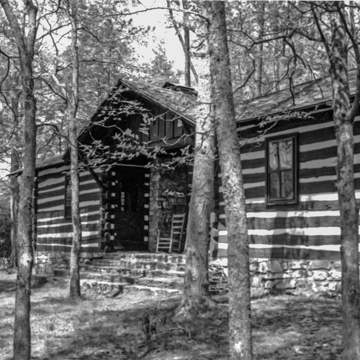Fairy Stone State Park covers almost five thousand acres of land donated by Junius B. Fishburn of Roanoke and sculpted by the Civilian Conservation Corps (CCC). The park is named for the iron aluminum silicate formations shaped like crosses that occur naturally in the area. The park's focal point is the 168-acre Fairy Stone Lake with a beach area for swimmers. Although a few changes and additions have been made over the years, the park is remarkably close to its original design. Of the CCC structures still standing are nine rustic log cabins, a restaurant, picnic shelters, campgrounds, a bunkhouse, and a log outhouse. Cabins 1 to 9 were built in a variety of forms, but all are of dark-stained, squared logs with white chinking and have large, interior stone chimneys, stone foundations, and deep eaves. Most of the horizontally laid logs of the cabins have rough round notching but a few have V-notching. Only at Cabin 1, the first one constructed, are the logs set vertically. These rustic cabins are beautifully situated in a woodland setting on or near the lake. The long, three-sectioned bunkhouse built as a dormitory for the CCC workers has vertical board-and-board sheathing and a stone chimney. The stables, with vertical board-and-board sheathing below horizontal sheathing, have louvered windows for the stalls and a hoist, gable-end door for storing hay in the loft. The CCC stables and equestrian paths, like the rest of Fairy Stone's architecture and landscaping, are skillfully blended.
You are here
Fairy Stone State Park
If SAH Archipedia has been useful to you, please consider supporting it.
SAH Archipedia tells the story of the United States through its buildings, landscapes, and cities. This freely available resource empowers the public with authoritative knowledge that deepens their understanding and appreciation of the built environment. But the Society of Architectural Historians, which created SAH Archipedia with University of Virginia Press, needs your support to maintain the high-caliber research, writing, photography, cartography, editing, design, and programming that make SAH Archipedia a trusted online resource available to all who value the history of place, heritage tourism, and learning.















